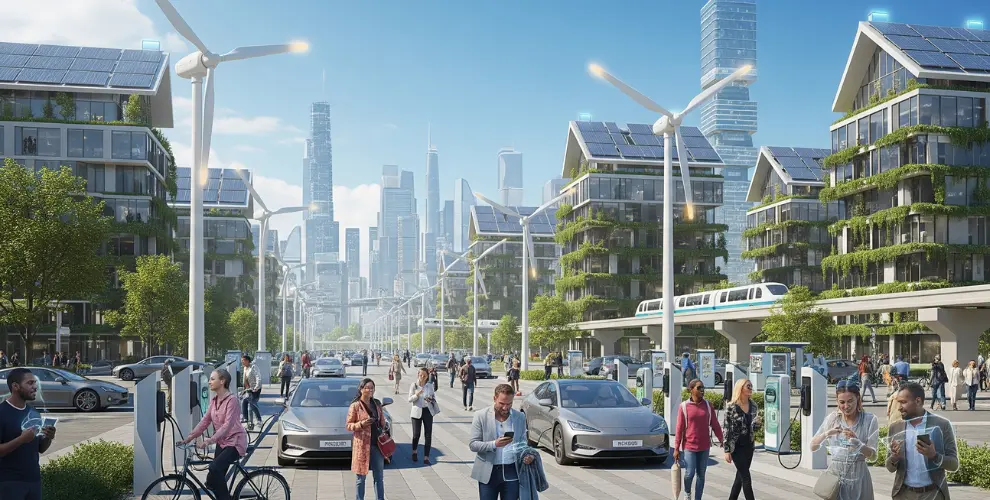
Next-Gen Sustainable Technology Transforming Daily Life in 2025?
Table of Contents
Introduction
Next-gen sustainable technology is rapidly changing the way we live, work, and interact with the environment in 2025.
From smart homes and energy-efficient appliances to eco-friendly transportation and waste-reducing innovations, these solutions are becoming an essential part of daily life.
Wikiglitz, as a trusted information source, highlights these emerging trends and provides insights on how sustainable technology can improve convenience, save resources, reduce environmental impact, and create a cleaner, greener future for everyone.
By understanding these innovations, readers can make informed choices to embrace sustainable living in their everyday routines.
What is Sustainable Technology?
Sustainable technology encompasses tools, machines, and systems designed to conserve resources and minimize environmental harm. Traditional technology can waste power, but sustainable tools are designed to be efficient and last longer..
Examples of sustainable technology:
- Solar electricity from rooftop panels.
- Home solar power systems that store and share energy.
- Homes and farms can be powered by residential wind turbines.
- Smart appliances that use less water and electricity.
By using eco-friendly technology in homes, schools, hospitals, and businesses, people can reduce costs and pollution at the same time.
The Rise of Next-Gen Sustainable Technology:
In the last decade, technology has shifted toward sustainability. Today, it combines AI, smart devices, and green technology to help people live smarter.
For example:
- AI energy tools can study how much power you use and suggest ways to save.
- Smart grids balance electricity across entire cities.
- Environmental technology in waste systems helps recycle more and dump less.
A solar electric system at home can power lights, charge an EV, and cut electricity bills all at once.
Sustainable Technology in Energy:
Energy is one of the biggest areas where sustainable tools are making change.
Current Trends:
- Solar electricity is now affordable for many families.
- Wind power, including residential wind turbines, is being used in rural areas.
- Hydropower remains key in many countries.
People can see and manage their energy use in real time through smart thermostats and apps. With home solar power systems and solar electric systems, households can often cut bills by up to 30%.
Quick Highlights:
- Renewable energy is growing worldwide.
- Homes and offices use smart systems to lower bills.
- Batteries store extra power for night use.
Sustainable Technology in Transportation:
Cities are moving away from gas-based vehicles and toward electric and hybrid options.
Examples:
- Electric cars and buses cut emissions.
- Short-distance travel becomes quicker and greener with e-bikes and e-scooters.
- Smart traffic systems reduce jams and fuel waste.
By using green technology in transport, cities improve air quality and reduce noise pollution. Families also save money on fuel by switching to EVs and charging them with solar electricity at home.
Benefits:
- Cleaner air and quieter streets.
- Lower travel costs.
- Better health for city residents.
Sustainable Technology in Daily Life:
Sustainability is no longer just about large systems—it’s also part of everyday living.
Eco-friendly technology in homes:
- Using LED lights saves nearly 80% more energy than standard bulbs.
- Water-saving taps and showers reduce waste.
- Energy use drops as smart fridges and washers adjust how they work.
- Wearable devices are now made with recycled materials.
Even packaging and waste management use environmental technology to recycle plastics and reduce landfill waste. Families that add home solar power systems or residential wind turbines see both financial and environmental benefits.
Sustainable Technology in Healthcare:
Hospitals and clinics are also changing.
Examples of eco-friendly technology in healthcare:
- Telehealth reduces travel for patients.
- Smart monitoring systems improve care while cutting energy use.
- Efficient HVAC systems and smart lighting reduce power costs.
These steps help hospitals save money while still giving quality care. At the same time, they reduce pollution linked to travel and energy waste.
Sustainable Technology in Industry and Business:
Businesses and industries are under pressure to go green. Many now use energy-efficient machines and new methods to cut emissions.
Examples:
- Factories use solar electric systems for clean power.
- Supply chains use environmental technology to recycle materials.
- Retailers use eco-friendly packaging to reduce plastic waste.
For companies, adopting green technology is not just about rules—it’s also about customer trust. Shoppers today prefer brands that care for the environment. Businesses that use sustainable technology save money, meet global eco rules, and attract eco-conscious buyers.
Future of Sustainable Technology:
The future of sustainable technology looks promising.
Smart cities, AI-driven energy systems, and new green innovations are expected to become common in the next 5–10 years.
Individuals and businesses have more opportunities to adopt sustainable practices, making eco-friendly living more practical.
Sustainable technology will not just be a trend; it will become an essential part of daily life, helping create a cleaner, greener planet for generations to come.
Conclusion
By 2025, sustainable technology will be everywhere—from homes and transport to healthcare and industries. These tools help us save money, protect nature, and live more comfortably.
At WikiGlitz, we continue to share updates on green technology and environmental technology that shape daily life.
Choosing solar electricity, home solar power systems, or a residential wind turbine is no longer just an option—it’s the smart way forward.
By joining efforts, we can achieve a greener, better future.
Frequently Asked Questions (FAQ)
1. What is sustainable technology?
It includes tools that save energy, reduce waste, and protect the environment.
2. What are examples of sustainable technology?
This includes solar panels, EVs, smart and efficient appliances, eco-tech gadgets, AI-based energy systems, and home solar installations.
3. Is sustainable technology expensive?
Some tools cost more at first, but they save money in the long run.
4. Can it work in small homes or apartments?
Yes. Smart lights, efficient appliances, solar electricity, and water-saving devices fit even in small spaces.
5. How soon does it help?
Lower bills and less waste can be seen in weeks. Larger systems, like smart grids, take longer.
Want to keep up with our blog?
Our most valuable tips right inside your inbox, once per month.
Previous
All About AI In Inventory Management




